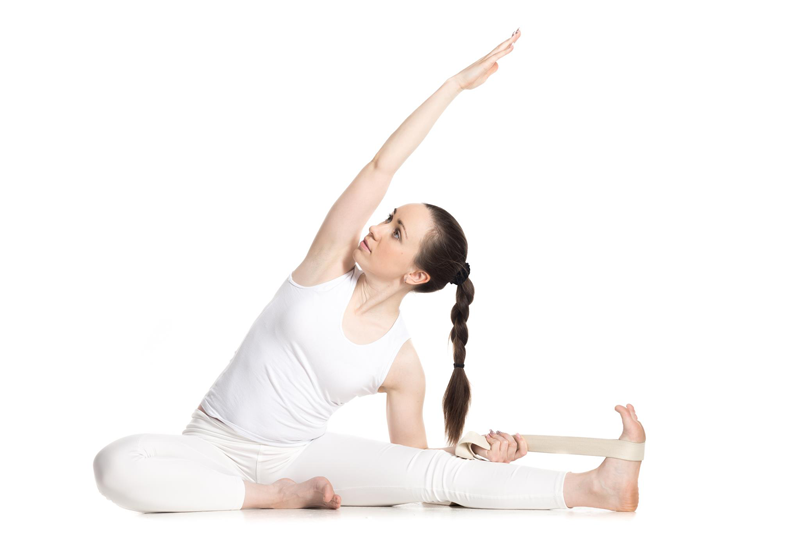If you’re hoping to take your practice to the next level, consider picking up a yoga strap. Also known as a yoga belt, a strap is made from strong material that doesn’t stretch. The prop is typically used as an exten-sion of the limbs to provide support when using asanas. Practitioners often find that their muscles aren’t flexible enough to practice a posture correctly. A yoga strap allows yogis to perform the pose properly, even when their limbs don’t quite reach. A strap can also be used to assist restorative poses to hold the limbs in a certain position. This allows practitioners to get the most from the pose without having to use their muscles.
Yoga straps come in a variety of different lengths and widths and are made from a strong material that does not stretch. The length of the strap can be adjusted with the buckle or fastener, so each strap is suitable for practitioners of all sorts. When using a strap, it’s best to wear a tight-fitting yoga vest to prevent the material from getting caught. In this article, we explore the yoga strap in more detail.
Things to Remember
Straps are typically used in a loop, so it’s important to get a strap long enough to hold each side. While most straps are adjustable, make sure you get a strap that adjusts enough to hold comfortably. However, there is no point in getting a strap that is way too long. The shorter you are, the shorter strap you need. Going for a shorter strap will mean you have to adjust it less before use.
It’s always best to warm up before using the strap. To avoid straining your muscles, practice some sun salutations before getting started. Warming your muscles and tendons will allow you to stretch further and get the most benefit from your yoga strap.
Before choosing your strap, consider where you will be using it. Most straps come with either a plastic or metal buckle. Although a metal buckle is more durable, it can be noisy when used on a hard floor. If you’re planning to use your strap at a yoga class, a plastic buckle may be the best option.
In addition to making postures easier, straps can also be used to make poses more challenging. If you feel like taking your practice to the next level, try working a strap into your regular routine to add something extra.
How to Use Your Strap
General Back Alignment
Many yogis use the strap for general back alignment. Wrapping the strap around your body can prevent you from slouching whilst you practice. Over time, slouching can lead to backaches, tension, and head-aches, so it’s best to avoid it if possible. To prevent slouching, place the strap around the back of your neck. Next, wrap the ends of the strap down and under your armpits before crossing them around your back in an ‘X’ shape. Finally, pull the ends of the straps to the front of your body and tie them together. The tighter you make the strap, the better your posture. Over time, your body will remember this posture and the strap will no longer be necessary.
Cow Face Pose
Cow Face Pose is used to open the chest and spine. To practice the asana, sit down on your mat with your strap in your right hand. Reach your right hand over your right shoulder and your left hand behind your back to grasp the other end of the strap. You are in Cow Face Pose. Hold the posture for 30 seconds whilst breathing deeply. If the pose feels too easy, move your left hand up the yoga strap as far as you can.
Seated Forward Bend
Seated forward bend increases flexibility in the back and legs; however, many yogis find they aren’t flexible enough to practice the standard asana. Using a yoga strap makes the pose a little easier for those who aren’t as flexible! To practice the asana, sit on your mat with your legs out in front of you. Loop the strap around your feet and use it to pull your yourself forward. Eventually, you should be able to reach forward enough to touch your toes. You are in Seated Forward Bend. You should feel a stretch along your back and hamstrings. As your flexibility increases, shorten the length of the yoga strap until you don’t need it anymore.
Bound Angle Pose
Bound Angle Pose stretches the groin, knees, and inner thighs. For those with tight hips, this posture can prove difficult without a strap. Using a strap allows yogis to move slowly into the posture until their flexibility increases. To practice the asana, sit down with your back straight and your legs out in front of you. Bend your knees and draw your feet toward your pelvis, touching the soles of your feet together. If you cannot bring your feet close to your pelvis, place a strap around your feet and loop it around your body. You are in Bound Angle Pose. Tighten the strap gradually to move your feet closer to your pelvis. The more you practice the posture, the tighter you’ll be able to make the strap!
In Summary
If you struggle with flexibility, a strap can make asanas easier to practice. If you’re not sure how to use a yoga strap, consider attending a local class. There, an experienced instructor can guide you through the process to ensure you use the prop correctly. If your session is within walking distance, pick up a spacious yoga bag to transport your gear back and forth.

